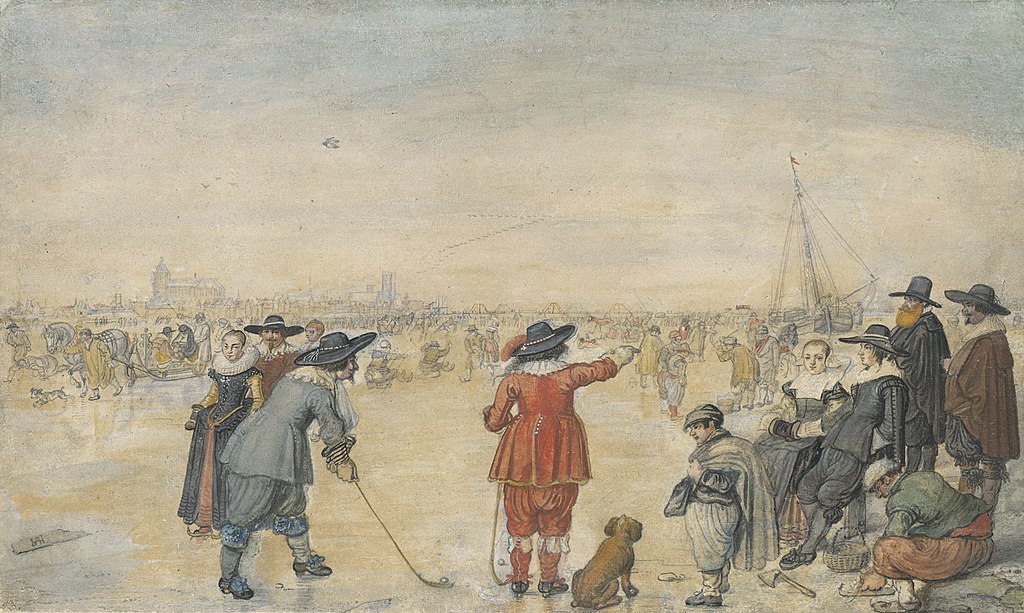A New Scotch Joke
by Richard H. Amerma
de Halve Maen, July, 1958
The royal and ancient game of golf, claimed so vociferously by Scotland, was brought to this country, not by the men from the hielands, but by the Dutch. The first mention of the sport in American annals is in an ordinance issued by none less than Peter Stuyvesant which forbade the burghers to use the streets of the city any longer for “the game of golf.”

Washington DC National Gallery of Art, Woodner Collection
Dutch settlers here brought with them athletic skills and contests from Patria, their homeland. Long regarded as a Scottish institution, substantial evidence exists that the game of golf originated in Holland. And, while not always esteemed by the Dutch colonial authorities in America, other evidence suggests that the game attained popularity in New Netherland long before it appeared in the English colonies.
Accustomed to a strenuous life, it is not surprising that Dutchmen were ardent golfers in addition to their fondness for bowling and other outdoor sports. In New Netherland, the terrain about Fort Orange and village of Beverwyck (Albany) proved suitable for golf. In 1660 Dutch enthusiasm for the sport brought warning admonition from the local authorities. At that time, the Fort Orange court spoke of hearing “divers complaints from the burghers of this place against playing at golf along the streets, which causes great damage to the windows of the houses and exposes people to the danger of being wounded, and is contrary to the freedom of the public streets.” The worshipful magistrates thereupon ordered all persons to refrain from golf in the streets, “on pain of 25 florins for each person who shall be found doing so.”
Earlier at Fort Orange, in 1657, the court dealt no unkindly with Bartholomeus Hoogeboom, a Hudson River skipper with an abiding interest in the game. His wife, Catryn, was possibly the first “golf widow” in America. Records show that the authorities called Bartholomeus to account for playing golf on a public prayer day. Evidently he was let off with a warning.
In the other American colonies, documentary evidence indicates that during the 1780’s golf was popular in Savannah, Ga., and Charleston, S. C. Since then, of course, particularly after the 1880’s, golf has become a major factor on the athletic scene. Last year nearly 4 million golfers played on more than 5,000 courses in America.
Historically, this delightful and aggravating sport relates back to an ancient Roman game, paganica, played with leather ball and crooked stick. In medieval times the word “golf” came into existence, apparently from the Dutch word kolf, meaning club. Hollanders often played their game in winter on frozen ponds and canals. In the southern Netherlands (now Belgium and Northern France), golf was sometimes played along roads.
As early as 1390 the Dutch, men and women alike, played golf in the Zaan area. The single club they used was akin to a hockey stick. Specimens of this implement and the type of golf ball, a leather sphere somewhat larger than a baseball, are still to be seen in Holland. Caddies, human or motorized, were unknown. Primitive playing conditions, while lacking today’s immaculate greens and scientific hazards, allowed plenty of exercise that was free from tensions sometimes evident in the modern game.
An early form of golf, played on the ice, is depicted in a Dutch winter scene painted by the 17th-century artist Avercamp. Graphically showing dress and equipment then in use, the picture is now in the Rijksmuseum at Amsterdam. That women played “kolf” then clearly appears from another painting, the original of which is at Kennemer Golf Club in Zandvoort. The two Dutch ladies in that picture, in voluminous garb, are shown standing on the fairway. Both are holding golf clubs, and one of them apparently is about to address the ball. A coat-of-arms dating back to 1720, which consists of a pair of crossed golf sticks, is to be seen in the church at Culemborg near Utrecht. On it appears the name of the church organist, an ardent golfer identified as Anthoni Klick, from whom the golf term “cleek” may derive.
Records going back to the 15th century refer to Dutch golf balls being brought into Scotland in large numbers. The Scots, with whom golf became the national game after a period of official displeasure, it appears were the first to play habitually across open fields. Already “ancient” in Scotland, the sport became “royal” when it attracted the patronage of the Stuart kings in that country and in England. The Royal Blackheath Club, near Greenwich in England, relates back to 1608. St. Andrews in Fifeshire, Scotland, on the shore of the North Sea near Dundee, began in 1754.

